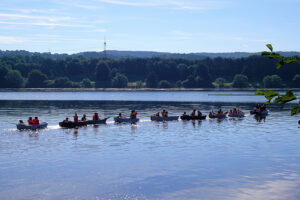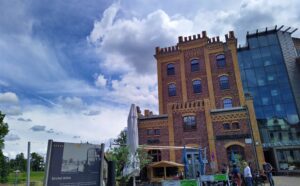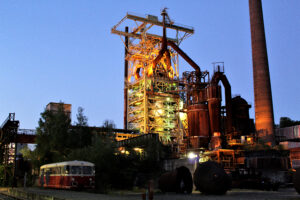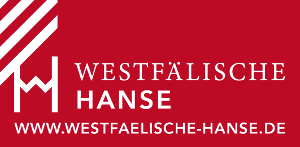What could be nicer in summer than being somewhere by the water?
You don't have to go far afield, because with the Ruhr and the Kemnader reservoir, you have water right on your doorstep. The Ruhr is one of the six major tributaries within North Rhine-Westphalia that flow into the Rhine in Duisburg after a length of around 219 kilometres.
The Ruhrverband operates eight dams with a total volume of 463 million cubic metres. In terms of a single river basin, this is the largest interconnected reservoir system in Germany. Did you know that?
The main function of the dams is to secure the water supply for around 4.6 million people. In addition to the eight dam walls and dams, the Ruhrverband is responsible for the operation and maintenance of 47 gauging stations and 33 precipitation measuring stations as well as for the hydraulic engineering management of 14 hydropower plants. All barrages are used to generate electricity using hydropower. The reservoirs are equipped with hydropower plants for this purpose. Lake Kemnader was the last barrage to be completed on the Ruhr in 1979.

Footpaths and cycle paths along the Ruhr are becoming increasingly popular. Between June and October 2022, counts and surveys of cyclists were carried out along the Römer-Lippe-Route and Ruhrtalradweg long-distance cycle routes on behalf of Ruhr Tourismus GmbH (RTG). The Ruhr Valley Cycle Route recorded 932,200 day trippers, over one million days spent on the route and a gross turnover of almost forty million euros from overnight and day visitors. That's amazing! The monuments of cultural and technological history in the central Ruhr Valley are particularly exciting for visitors.
One of the most important cultural-historical buildings in Westphalia is located on the Ruhr slope in Bochum-Stiepel. The Stiepel village church from the 12th to 16th centuries is richly decorated and is a place of tranquillity. Its wall paintings are particularly well preserved and were once not only decorative, but also had the task of illustrating the biblical content to the generally illiterate population of the Middle Ages.

On the way to the Ruhr, you come across the mighty Birschels Mühle mill.
The eponym Gottlieb Birschel was born in 1882 and died in 1954 in the miners' hospital after a short illness. The Birschel family ran the mill as a family business. The mill was powered by water wheels until 1866, after which steam power was added as a further source of energy. Just four years later, the mill was powered by turbines. The quality of the flour was particularly renowned. 3000 hundredweights of grain could be processed per day into brand names such as "Ruhrperle", "Ruhrgold" or "Ruhrblume". Birschel's mill became one of the most successful businesses in its sector. Changes in the sales market and the formation of groups in the milling industry led to the demise of the 100-year-old family business in the summer of 1955. In 1989, the former mill on Schleusenstraße was sold. Today, there are 43 flats suitable for senior citizens and a hotel in the industrial monument. The representative mill house, built in 1902 and resembling a castle, is still a popular photo motif today.

On the banks of the Ruhr, the view naturally falls on the Hattinger Henrichshütte, the most traditional ironworks in the Ruhr region, which provided work for 10,000 people in its heyday and is now an industrial and landscape park with a museum.
Did you know that the riverbed of the Ruhr was even relocated for the Henrichshütte?
It was decided in 1956 and began on 21 May 1959. 60 to 75 lorries were used, depending on requirements. Nine excavators, eight bulldozers and five scrapers. Enormous quantities of material, including a lot of rock, had to be moved and transported away. From 1 November 1959, the Ruhr was in its new, approximately
1.5 kilometre long bed. This shortened the river by several hundred metres. The areas previously used for agriculture could now be converted into industrial sites. The area of the smelter grew by 480,000 to 1.31 million square metres. An ore store, a sintering plant for the production of 50,000 tonnes of sinter (slag) per month and other operations were built on the additional land.
Another blast furnace was built, and a test centre and the factory administration building were constructed. A transshipment station for bulk goods was also built. New factory halls were built on 50,000 square metres and there was space for the storage of 500,000 tonnes of ore. The restructuring of steel production began with the modern continuous casting plant and the construction of the LD steelworks. This enabled the company to increase its capacity, making it the largest company in the central Ruhr Valley for a long time. When the sky glowed red in the dark from the reflection of the molten iron during a blast furnace tapping, it was a special experience even for people who did not work at the smelter.
In 1963, Ruhrstahl AG merged with Rheinstahl AG and ten years later, Thyssen Henrichshütte GmbH was founded following the takeover of Rheinstahl AG. The gradual decline began in 1983 and the last blast furnace tapping at the Henrichshütte took place on 18 December 1987. The journey of iron and steel can still be experienced today in the LWL Museum Henrichshütte.
Without the Ruhr, people would not have settled in Hattingen. A nearby river determined the settlement and development of a town. Cycling and hiking with a view of the water - simply marvellous.
And of course you can also go directly onto the water at Lake Kemnade - take a trip on the passenger boat or go boating yourself. Leisure fun on the water right on the doorstep!





